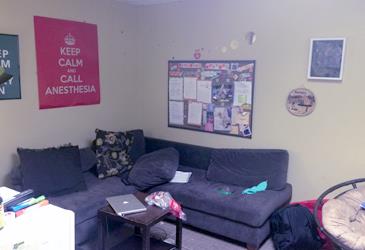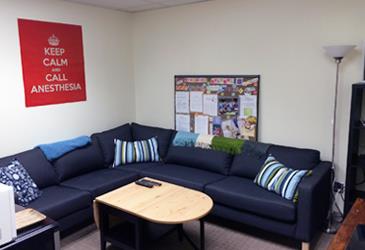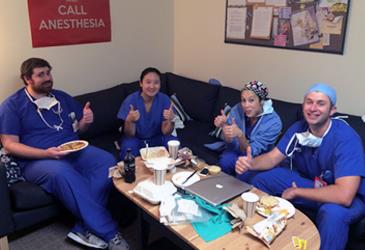Anesthesiology residents at Stanford used to spend their few precious moments of relaxation in a lounge that looked like a dirty apartment. With a low-budget, resident-led plan, they found the funds and redesigned the anesthesiology lounge—known as the “Gas Lounge”—into a space that is clean, calm and where they would actually want to eat and sleep.
The Gas Lounge "before"
Physicians spend a large portion of their lives at work and most of the time they get to actually relax is in the on-call room. Adam Was, MD, a fifth-year resident in the combined pediatrics and anesthesia program at Stanford, spoke this week to physicians at the International Conference on Physician Health™ in Boston about how he and his fellow residents redesigned their own on-call room.
The changes to the Gas Lounge came about through the Peer Support and Resiliency in Medicine Program (PRIME) at Stanford, which was built in 2010 around Jon Kabat-Zinn’s mindfulness-based stress reduction work and is intended to create a new culture that fosters interdependence, concern for others, self-care and emotional literacy. The program holds resident wellness retreats, regular wellness sessions led by faculty and wellness education sessions.
Then, in 2014, the addition of a scholarship for resident-driven wellness initiatives opened the door for residents in the program to make meaningful changes that affect their daily lives.
“It was really wonderful because they had these funds and made them available and invited residents to put together whatever ideas they could come up with that they thought might help resident wellness,” Dr. Was said. And the residents lead the programs.
Residents decide what goes into their home away from home
The Gas Lounge "after"
Dr. Was initiated a project to improve the Gas Lounge. It was feasible, could easily be implemented and was cost-effective. “We really wanted to empower the beneficiaries of the scholarship,” he said, “let the residents choose what they wanted, lead the selection of that and be a guide and a means to an end for them.”
The group surveyed the 79 anesthesia residents regarding their current use and satisfaction with the lounge. They asked for ideas for improvements as well as their permission to make those improvements “to make sure that they were on board and didn’t feel like we were changing the existing structure … and that we weren’t forcing any changes on people,” Dr. Was said.
In the initial survey, the residents suggested a total of 33 potential improvements ranging from couches, coffee tables and lighting to hot tubs and massage therapists—the latter of which were not quite feasible.
“We asked what kept them from using it more often,” Dr. Was said. “People said they use it pretty frequently … but in terms of limitations a good portion of people said it’s just too small, or it’s dirty, or they often forget their key.”
They also asked residents if they would use the lounge more often if these improvements were made and whether they felt these interventions would improve their well-being. Fifty-nine percent said it would improve their well-being—and so the group budgeted and began purchasing items and redesigning the Gas Lounge.
Revealing the Gas Lounge makeover
The selected improvements included a new couch, monthly cleaning, badge-entry rather than key-entry, snacks, phone chargers, new lighting and pillows and blankets among several others. Once the room was completely cleaned from top to bottom, they placed all of the new items in the room.
 Anesthesiology residents in the Gas Lounge
Anesthesiology residents in the Gas Lounge
Dr. Was said that some of the things they found under the old couch were not for repeating to an audience. “Suffice to say, I didn’t know that oranges could turn black,” he said. “And I don’t know how long that takes.”
In a post-intervention survey, residents were asked how often they used the Gas Lounge. Before the interventions, only about 20 percent of residents said they used it daily. After the interventions, almost 70 percent of residents said they used it daily.
One resident wrote in the survey, “I go to the Gas Lounge nearly every day for lunch because I know I can sit down with the people I love (my co-residents) and get a half hour of socializing and humor. It is also my home-base for those long call evenings, and essential for naps while on cardiac call.”
Another resident said, “The Gas Lounge is my home. If we didn’t have it I’d be an orphaned child … I love the new changes.”






